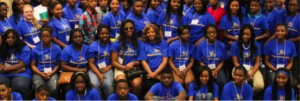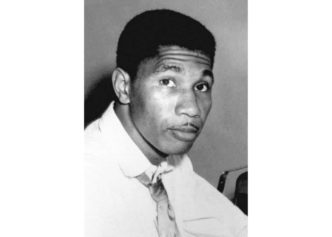
The banks of the Mississippi River, as seen from Great River Road State Park in the Mississippi Delta, where there is a dearth of structured activities for children in the summer. (Photo: Nick Chiles)
DREW, Miss. –– Drive down a dusty road in the Mississippi Delta in July and you will quickly come across a familiar scene: Kids, walking. Out of the house, no particular destination in mind. Ambling along. But the walking may be better than the alternative: Stopping. It’s the stopping that gets you in trouble.
“In the summer, all kids do is stay cooped up in the house, or walk around and get themselves in trouble,” said 18-year-old Kanita Perkins, who lives in this small town, described as the geographical center of the Delta, 20 miles or so east of the dizzying bends of the Mississippi River.
This entire region has become the American metaphor for scarcity, a land where dire poverty has defined existence for more than a century.
For parents in the Delta looking for summer activities for their children, it’s largely a D-I-Y affair: Do it yourself. There are so few programs for young people that families are left to their own devices if they want some meaningful enrichment for their children. And most of them don’t have the money for the fancy summer camps that middle-class parents sign up for without a second thought — cooking camps, dance camps, drama camps, music camps.
As students around the country begin returning to school this month, many from low-income families will be at a severe disadvantage because of how they spent their summer. For far too many children in the United States, there is such a significant academic regression during the summer months that studies have shown it is responsible for most of the achievement gap between poor and middle-class students.
In educational jargon, it is known as “summer learning loss” or “the summer slide.”
Researchers have found that students across the board lose about two months’ worth of math skills during the summer months. But in reading, middle-class students actually improve over the summer, while low-income students lose more than two months of achievement.
This means that if children are not intellectually stimulated during the summer, if they don’t read and engage in other activities to keep their brains firing at optimal levels, they will need weeks — if not months — to get back up to speed in the fall. Teachers will have to spend so much time reviewing material students were taught the prior school year that children who were already behind their wealthier peers will lag even further.
Material forgotten. Time lost. Money wasted.
Sidebar: Stopping Summer Slide: What’s a Parent To Do?
An argument can be made that summer slide is the most severe under-addressed problem in the American education ecosystem. After all, fixing it would mean stomping on the American idyll of lazy sun-drenched days. Summers are the precious amber of so many childhoods. Year-round schools? That would be like desecrating apple pie.
“The issue is incredibly important and has a tremendous potential to change outcomes for kids in this country,” said Sarah Pitcock, CEO of the Baltimore-based National Summer Learning Association. “I think the reason we don’t see it talked about as much as you would expect is there are a lot of entrenched systems and infrastructure built around summer break. And there are also widely held beliefs that summer is a time off, summer is a time for rest and vacation and all of those things that comprise the idyllic summer. But that kind of summer does not exist for at least half of the children in this country who live in poverty.”
“There are widely held beliefs that summer is a time off, summer is a time for rest and vacation and all of those things that comprise the idyllic summer. But that kind of summer does not exist for at least half of the children in this country who live in poverty.” —Sarah Pitcock, CEO of the National Summer Learning Association
In Mississippi, the stakes are about to be heightened exponentially in the coming school year with the third-grade “literacy gates” testing in May; most third-graders must pass a reading proficiency test or be held back. Students who regress during the summer could find themselves sliding all the way back to another year in third grade.
Educators believe one of the best ways to keep students engaged during the summer months is in programs that mix fun with academic enrichment. Thousands of such programs across the country step into the breach to make a difference in the lives of young people, particularly in poor communities. If the nation is going to make a substantial dent in the summer slide, expanding and enlarging these programs would be a good place to start.
In Jackson, Operation Shoestring to the Rescue
While she’s never heard the term “summer slide,” 11-year-old Cayden Taylor is quite clear on what can happen to her and her classmates when they return to school after a lazy summer.
“When you go back, you forget everything,” she said.
But for this rising sixth-grader in the Jackson, Miss., public school system, this summer was different. This year, Cayden’s mom enrolled her in Operation Shoestring.
For more than 40 years, this nonprofit has fought gamely to provide academic enrichment, remediation and support to kids in Mississippi’s largest city. In addition to an after-school program, Shoestring offers a six-week summer program that provides both academic stimulation and activities. The program staff is proud of the progress they have been able to make with students during the summer months — progress frequently recognized by the surrounding schools, which often direct students to the program.
Operation Shoestring’s latest analysis shows that the students who attend its summer program do better on district tests than their peers who don’t: Specifically, while students in the district show a decrease in their average test scores from the spring term to the first term of the next school year, the students from Shoestring show a much smaller decrease.
But the program reaches just 250 students in grades 1 through 12. There are 30,000 in the Jackson public school system. Staff members say the phone is ringing constantly in the early spring as parents look to enroll their children; the slots fill up quickly.
“If we had more resources, we would expand the scope and depth of what we can offer,” executive director Robert Langford told AtlantaBlackStar. “While it seems like we served a lot of kids, it’s just the tip of the iceberg.”
Operation Shoestring is one of thousands of programs across the country that serve as beacons in poor communities severely lacking in most everything a child needs. Chronically underfunded, they often must treat the summer as an exercise in triage, tackling as much of the academic stuff as they can while keeping the kids safe and fed. When Shoestring ended July 11, there was still another month before the start of school, meaning parents had to figure out something else, add another stitch to the complicated quilt of summer activities. Some of the older kids were just at home.
Langford said he would love to extend Shoestring for the whole summer, but he can’t afford it.
In a state where it sometimes feels like painful memories from the Civil Rights Movement lurk around every corner, Shoestring also has a legacy from that time. It was founded in 1968 by sympathetic whites who wanted to promote racial healing after James Meredith — the first African-American to integrate the University of Mississippi — was shot by a white man in 1966 during his March on Fear from Memphis to Jackson to encourage Blacks to register to vote.
Langford said Mississippians, so accustomed to making do with less, have to fight to make sure they don’t become too complacent and accepting of the culture of scarcity.
“Too often we tailor our expectations,” said Langford, 50, a white man whose own parents moved to Mississippi from Virginia during the summer Emmett Till was killed in 1955 and who raised him with a keen sense of social justice. “We’re poor, poorly educated, have a legacy of slavery, have institutionalized racism, have lots of injustices born of racism. We need to not carry that forward. We need to make sure we don’t limit our visioning and resourcefulness and actions because of the culture of scarcity.”
Mississippi’s Scarcity Disproportionately Felt by Blacks
In Mississippi, the state with the lowest per capita income in the U.S., where leaders have never funded the schools at adequate levels, the Black community bears the brunt of the miserly ways. Of Mississippi’s population of 3 million, 37 percent are Black — and nearly half (44 percent) of those Black people live in poverty. Arkansas is the only state with a higher percentage of African-Americans in poverty, at 48 percent.
Cognizant of costs, Operation Shoestring offers six weeks of programming, Monday through Thursday from 7:30 a.m. to 5:30 p.m., for a total charge to parents of $50. Yes, $50 for the full program. (The program is funded primarily through foundation grants and private donors.) While the mornings are filled mostly with reading and math, afternoons are a dizzying mix of activities like sports, cooking, swimming and games.
“We always have a waiting list,” said Amber May, a former teacher who serves as Shoestring’s program manager. “The parents start calling in January asking if we started accepting kids yet. They want somewhere for them to be. They don’t want their kids to just be at home by themselves. In some cases that’s what ends up happening because they may not find a summer provider that has hours compatible to their work schedule or that they can afford. Some summer programs charge like $150 a week. Our $50 is just the activity fee for the field trips. Parents want to make sure they’re in a safe place, and that they’re going to learn a little bit as well. But we need more summer providers in this community so we don’t have kids just walking up and down the street. And we can only do six weeks. Toward the end we have parents asking us, ‘What am I going to do now? I’ll pay you another fee.’”
After the summer program ended, May said, she could look out her window and see some of their students aimlessly walking up and down the street.
May is worried about what will happen to the little ones who are facing the literacy gates test in third grade. Just slightly more than half of third-graders in the state tested at or above grade level in reading in 2011. Many educators are particularly afraid of what this new initiative will mean for poor and Black children. The brunt of the policy will fall on them, and they will surely be blamed for their failures, as will their traditionally underfunded schools.
Mississippi joins more than a dozen other states, including Tennessee, California, Florida, Georgia, and Maryland, as well as Washington, D.C., that have imposed this barrier to promotion in third grade with the hope that it will prod the schools and communities to do a better job of teaching more young ones to read.
In the age of high-stakes testing, it has become a familiar American story: Starve poor kids of resources, then blame them when their results lag behind wealthier kids in financially flush school districts.
With a wary eye toward May 2015, when the promotion test will be administered, Shoestring spent extra time on literacy with the little ones over the summer, even bringing in Junior League of Jackson volunteers to work intensely with the second-graders for two weeks.
Just down the road from Shoestring’s modest building, which stands on a busy street near several churches and a convenience store, children of various ages gather in a small park, the younger ones squealing on the playground and darting through the overgrown weeds, the older ones loitering under a gazebo, grateful for the shade on a typically scorching Mississippi summer afternoon. Their only entertainment appears to be the company of others.
This is a classic summer scene in Jackson, a visual emblem of the lack of summer stimulation. It is a scene that’s repeated throughout the United States, in urban centers and rural towns, in housing projects and on lazy country roads.
“Kids need to be doing more [during the summer],” said Cayden’s older sister, India Brown, 27. “My neighbors, I see them in the morning time from about 8 o’clock all the way up to 11 at night, outside playing. They just playing, all summer long. But my mother ain’t going for that. We make sure Cayden reads her books and does the things she needs to do. She can play later.”
After Shoestring ended, Cayden had to spend the rest of her summer at McDonald’s with her older sister, who works as a manager there, while their mom went to her job with the Jackson Housing Authority.
“I take naps, read books, listen to music, play games,” said Cayden, a bubbly, energetic child who is never at a loss for words.
Does she also eat a lot of McDonald’s?
Cayden grinned and nodded.
Bringing Change to the Delta
In the Mississippi Delta, the needs are even greater than in Jackson — and there are fewer programs around to fill them. But four years ago, an irrepressible woman named Gloria Dickerson swooped into the summer void here, starting the We2gether Creating Change program, which she hoped would give the children of Sunflower County the many things they were missing.
In addition to working with them on literacy, Dickerson started adding different elements to her summer program: a choir, a drama club, an art class, a dance team, a chapter of the 100 Black Men organization, a T-shirt printing business, a spelling bee to help with literacy.
She even started a food pantry for the residents of Sunflower County.

Gloria Dickerson, founder of the We2gether Creating Change program in Drew, Miss., surrounded by her charges. (Photo courtesy of We2gether Creating Change)
Every year, she takes 100 students to Disney World in Orlando, in addition to other exciting spots, with the idea of showing them how much pleasure there is in the world outside of the Delta.
The program runs until the end of July for the students beyond grade 6. The program for the younger students stops at the end of June.
Dickerson, 61 (whose maiden name is Carter), knows all about the scarcity of summer activities in the Delta. Fifty years ago she, too, was a young person here, struggling along with her 12 siblings to get enough food in their bellies so they would have the energy to assist their sharecropper parents in the cotton fields.
When she was 11, Gloria’s parents made a decision that would change all of their lives: They decided to send their children to the all-white public schools in Sunflower County, Miss. The brutal ordeal that the children of Matthew and Mae Bertha Carter endured desegregating the schools of Drew is chronicled in two books and one documentary, making the Carter family local civil rights heroes in the Mississippi Delta.
The Carters didn’t set out to be heroic. They just wanted their children to have an education that would help them escape the unremitting toil of the sharecropper’s life. As Matthew Carter told author Constance Curry in the 1995 book Curry wrote about the family’s ordeal, Silver Rights, when he and Mae Bertha received a letter from the Drew school board instructing them to send their children to the school of their choice, “We thought they meant it.”
“My mother said, ‘If you do this and stick with it, you will reap the benefits,’” Dickerson said, sitting near the storefront window of her program, which overlooks Main Street in tiny Drew, with no more than a dozen storefronts, including an old drug store, an antique shop, and several adult hospices and clinics. “So we took it, all of the harassment, people kicking us, throwing things at us, shooting into our house, the family being put off the plantation, being hungry at night. I got called ‘nigger’ so much I have a hard time even saying the word now. We took all that because our mother said it’s for the best. She was right.”
After attending the University of Mississippi and then spending decades in corporate America, holding big fancy jobs, including comptroller of the W.K. Kellogg Foundation, Dickerson eventually retired and found her way back to Drew.
‘It’s Not Supposed to be This Way’
Dickerson is driven by the desperate needs she sees all around her. She knows that in too many cases, her program is the only thing that will rescue the youngsters in Sunflower County from a life of grinding poverty — adding yet another generation to a family cycle that was established more than a century ago. With thoughts like that, Dickerson can’t help but to keep pushing.
“Mississippi has 182 school districts, and when I came back I found out Drew is ranked 182, meaning it’s the worst in the state,” Dickerson said. “Since Mississippi is worst in the nation, that means…”
Her voice trailed off as she shook her head, shuddering at the thought that her birthplace now houses the worst schools in the United States. Over her lifetime, the schools went from all white to all Black.
“I apologized to the students,” she said. “I said, ‘I’m sorry; it’s not supposed to be this way.’ When I came back and went into Drew High School, the school I graduated from, I saw they had no water in the bathroom to wash their hands, no tissue. I said, ‘How do you use the restrooms here?’ They said they don’t — they either hold it all day or call their mom or dad to pick them up and bring them home so they can use the bathroom. I got choked up. When I went to school here, Drew High School was an excellent school, a clean, beautiful school. This is not what I sat in the classroom and fought for. We didn’t take all those licks to come back to this same school and see the condition it’s in. My mother is gone, but I wanted to tell her, ‘Mom, look what happened to these kids!’”
Dickerson started working first on students’ self-esteem, making them believe that the power to change the trajectory of their lives was inside of them. If she could do it, they could do it, too. Her program has a total of about 200 slots for youngsters from first grade to 12th grade — all of whom attend free of charge.
With an annual budget of about $400,000, Dickerson has received grants from funders like her old employer, the Kellogg Foundation, but she’s also used a considerable amount of her own money (and doesn’t take a salary), which has shown the skeptics in Drew that this lady really cares about them.
“I’m trying to give them everything a middle-class child gets. They need to have good times, to know life is supposed to be wonderful.” —Gloria Dickerson
“When I came back, I said, ‘I’m not going to treat them like they’re poor,’” said Dickerson, who also works with women in Sunflower County as a life coach. “I will treat them the way I like to be treated. Give them some of the things I’ve gotten since I moved from here. I’m trying to give them everything a middle-class child gets. They need to have good times, to know life is supposed to be wonderful.”
Ten-year-old Kaniya Perkins, who just spent her first summer in We2gether Creating Change, said that although she learned a lot in the program, it differed from school in one key respect: “We have more fun.”

(From left) Kaniya Perkins, mother Katrina Perkins, and Kanita Perkins at the offices of the We2gether Creating Change program in Drew, Miss. (Photo: Nick Chiles)
Her mother, Katrina Perkins, said she knows her daughters Kaniya and 18-year-old Kanita, a three-year veteran of the program, love We2gether because she didn’t have any difficulty waking them up early in the morning to get to the program, which runs from 8 a.m. to 2 p.m. during the summer. By contrast, during the school year, they’re dragging.
“When they’re here, sometimes they don’t want to leave and go home,” she said. “Before this program, they would sit home, play games, do the usual, bored out of their minds.”
Dickerson only has the capacity for about 200 students in her summer program right now. So while she can count on her youngsters to have enough intellectual stimulation to stave off the summer slide, Dickerson knows there are thousands of others in Sunflower County who get nothing. She’s a one-woman show, doing it all with just one full-time staff member, a few volunteers and a handful of part-time teachers.
But Dickerson won’t allow herself to feel despair.
“I want to transform Drew and transform Sunflower County so that 20 years from now it’s going to look like a completely different place,” she said. “The culture will have shifted. The kids will be graduating from high school. They’ll have hope; they’ll have faith. People will call this the jewel of the Delta. I can just see it.”
This story was produced in conjunction with The Hechinger Report, a nonprofit, nonpartisan education-news outlet affiliated with Teachers College, Columbia University.



